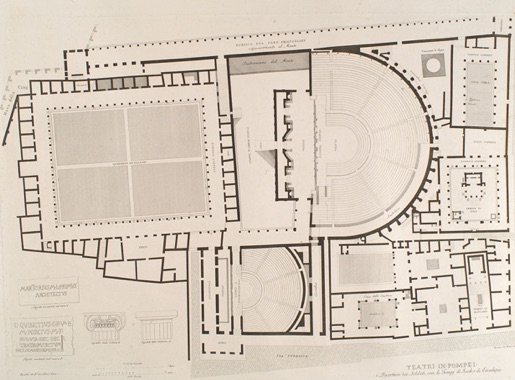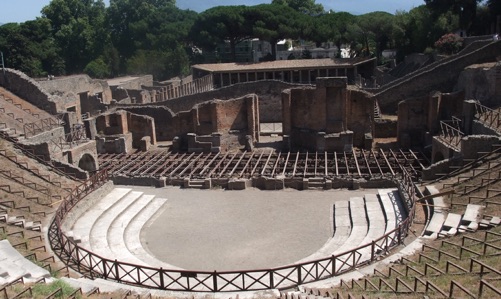Archaeological tours, packages and exclusive multy day excursions in Campania for tourists, lovers,
scholars and students.





Archaeological tours, packages and exclusive multy day excursions in Campania for tourists, lovers,
scholars and students.
The two centers of entertainment in the city of Pompeii was the amphitheater, located in the eastern part of the city, and the theaters located further west, near Port Stabiana.
From the II century BC. C. Roman cities used it as theater buildings to entire neighborhoods, often using the steepest places, where the natural slopes were used to construct the bleachers. In Pompeii the neighborhood of the theaters included several important buildings.
The Triangular Forum was built on top of a lava ridge to peak, marked by a monumental propyleum (input) completely rebuilt following the damage caused by the earthquake of 62 AD. C. In this square stood a Doric temple, possibly dedicated to Minerva or Hercules, dating from the V century. a. C., whose original plan was unclear as the only base is still well preserved.
The Samnite Gym, built during the second half of II century. a. C., when many civilian buildings were renovated in the city. It 'a rectangular building that has a colonnade on three sides except the east that was removed to give space to the Temple of Isis. On the western side there are two rooms, one of which was probably used as a changing room. In 1797 a statue was discovered in the gym, the finest ever found of a Roman copy of Doriforo of Polykleitos, now in the Archaeological Museum of Naples.


The big Theater in Pompeii
Map of the theaters in Pompeii
THEATERS IN POMPEII
The Teatro Grande, built in the Greek setting on the natural slope of the hill behind, is dated the second century BC. It has preserved its original appearance, despite the constant remakes, including the restoration of the Augustan age. The scene that was originally to be two floors, in imitation of the front of a building, was entirely rebuilt after the damage reported by the earthquake of 62 AD. C. In the Augustan era were built parodoi, side aisles covered access to the orchestra, gaining on them of the boxes (tribunalia) for guests of honor. One of parodoi is connected to a courtyard with a staircase leading to the Triangular Forum.
The cavea (tiers) is divided into three areas, that were said: ima reserved for senators, media to the guilds of the middle class, and summa for the populace.
This theater could accommodate about 5000 spectators, was restored during the Bourbon age and has, unfortunately, recently had a questionable vigorous action. The Odeion or Small Theatre, formed a homogeneous group with the Teatro Grande. This could accommodate about 1500 spectators, and the previous one, was smaller and covered. Was used for musical auditions, although some recent speculations recognize it as a building for political meetings, used as a stage covered only from the age of Augustus. The construction of the building around 80 BC was financed, as indicated by a dual enrollment, the two magistrates C. Q. Valgus and M. Porcius. Even here there were tribunalia intended for privileged spectators, and the auditorium was divided into three sectors. The decorations were very elegant, it is shown by the orchestra and the two marble telamons found on the steps.
The Quadriporticus dating from the II century a. C. and had, as also noted Vitruvius, the function of porticus post scaenam , that was an area used for walking during the interval by viewers of the shows or to protect themselves in case of rain After the earthquake of 62 AD C. was transformed into a Ludo gladiatorio (gladiators gym and accommodation), because the Palestra Grande was unavailable On the western side are a stable, a kitchen, warehouse, a dining room and a prison In these places were found human skeletons, weapons and armor belonging to the gladiators.
Pompeii Tour guide - Herculaneum Tour guide - Stabiae Tour guide - Oplontis Tour guide - Naples Tour guide
Amalfi Coast - Sorrento - Positano - Paestum Tour guide - Capua Amphitheater - Procida - Ischia - Capri
Copyright © Pompeiin.com - E-mail: info@pompeiin.com

